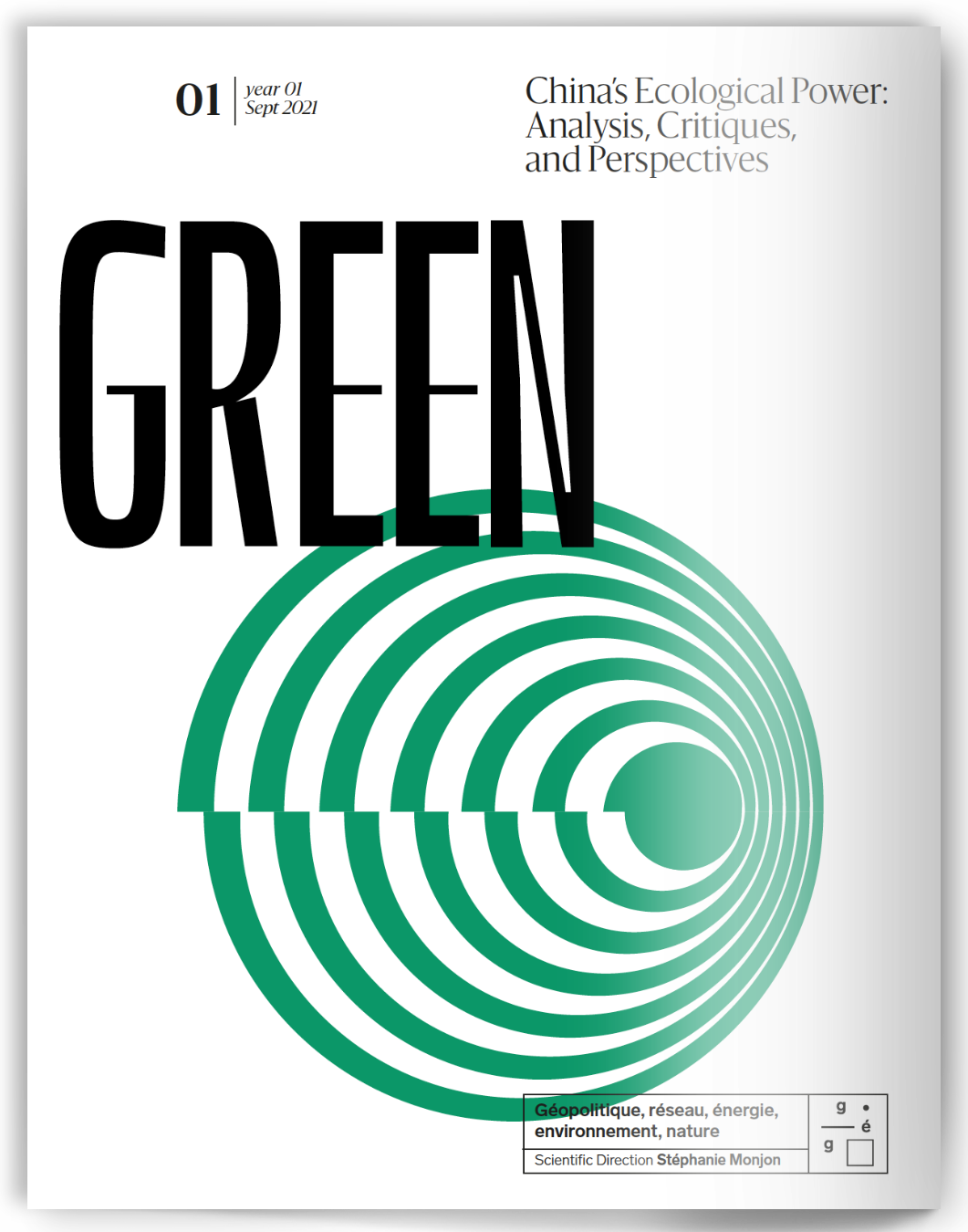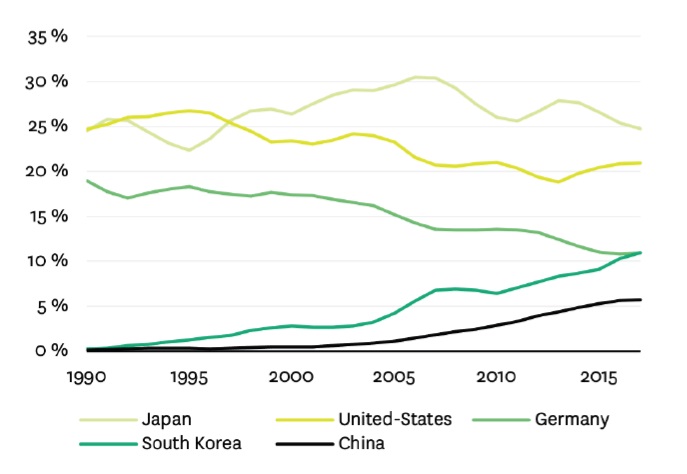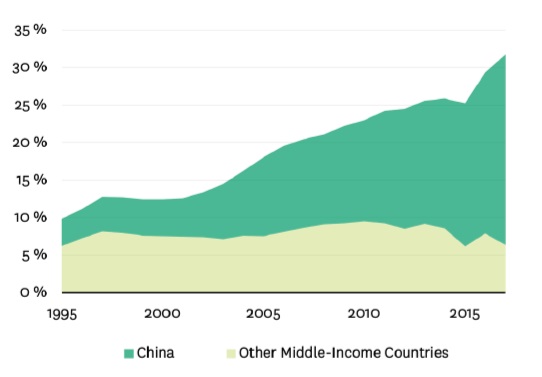China’s Contribution to Low-Carbon Technology Innovation
Issue
Issue #1Auteurs
Matthieu Glachant , Simon Touboul
21x29,7cm - 153 pages Issue #1, September 2021
China’s Ecological Power: Analysis, Critiques, and Perspectives
Keeping global warming to less than two degrees above pre-industrial levels, as stipulated in the Paris Agreement, requires the development of new technologies to more effectively reduce greenhouse gas emissions as well as their deployment in the economies which emit the most carbon. In this respect, China is a country of prime importance. Its technological needs are enormous, with current emissions volume equal to that of the United States, India, and the European Union. The country has just set itself a goal of carbon neutrality by 2060, which implies a drastic reduction in greenhouse gas emissions. It also plays a leading role in certain key sectors for the climate transition: the production of solar photovoltaic equipment, batteries, wind turbines, and the construction and operation of nuclear power plants. But does its contribution to global low-carbon innovation match its needs and potential? Is it among the leaders in the climate innovation race, or does it continue to depend on technologies invented in industrialised countries?
China’s low-carbon innovation through research remains limited
Patent data is commonly used to measure technological innovation made through research 1 . Each patented invention is classified in a very detailed nomenclature that allows the identification of patents protecting technologies which fight the greenhouse effect. Most countries in the world have data available which allows China to be compared with the rest of the world. However, the unit value’s lack of uniformity for patents poses a problem 2 . Indeed, a large majority of patents protect insignificant inventions while a small number concern significant inventions 3 . Directly using the number of patented inventions to measure innovation can therefore be misleading. The problem is particularly pronounced when it comes to qualifying China’s performance 4 . The country’s innovators have a stronger tendency to patent, including low-quality inventions, which artificially puts the country at the top of global innovation when measured by the number of patents 5 . There are several solutions to correct this bias. The simplest is to take into account only inventions protected in at least two countries 6 . The cost of patenting in one country is much lower than extending that protection to other countries. An extension therefore signals that the holder considers the prospects for his invention’s commercial use to be sufficient.
Figure 1 shows the evolution of Chinese low-carbon innovation from 1985 to 2017 using this indicator. Unfortunately, more recent data is not yet available. It shows that innovation was almost non-existent until the mid-2000s, with the number of Chinese patented inventions not exceeding 1% of the world total. Since then, the country has caught up remarkably well. In 2017, the country accounted for almost 6% of all global low-carbon inventions. This makes it the fifth largest innovator in the world, on par with France. This performance is respectable, but it remains well below that of the three leading countries of Japan, the United States, and Germany, each of which produces between 15 and 25% of global innovation. It is also half that of Korea which, like China, accounted for less than 1% of low-carbon innovation in 1990.
Figure 1 • Evolution of the share of global low-carbon, high-value inventions 7 of the five largest inventor countries 8

However, as Figure 2 shows, China is very active in two areas: low-carbon information and communication technologies (i.e. technologies that reduce the energy consumption of computer equipment and communication networks) and building technologies. On the other hand, its performance is no better than average in wind and solar photovoltaic energy, areas in which it has a very strong industry.
Figure 2 • Share of Chinese inventions in global innovation in 2017 by technological field 9

China is, in fact, not very specialised in low-carbon innovation. It accounts for only about 5% of patented inventions across all technologies, compared with twice that percentage for most industrialised countries. The increase in low-carbon innovation described in Figure 1 is thus due more to a general acceleration of innovation in the country than a reallocation of its efforts to combat climate change. In other words, Chinese innovators appear to be responding more to immediate economic needs than to be building a low-carbon technology infrastructure as part of a longer-term strategy.
Is China compensating for this relative weakness by importing foreign inventions? Patent data also provides some answers to this question. A patent provides an exclusive right to exploit the invention commercially for a certain period of time in the country in which it is filed. The fact that a foreign inventor files a patent in China therefore indicates his intention to deploy the protected technology there. The volume of patents filed by foreign inventors in China then indicates the level of international technology transfer to the country.
According to this indicator, China appears to be highly connected to international technology flows: the country received a quarter of global low-carbon patent exports in 2017. Lagging far behind, the other emerging economies together account for less than 10%. This percentage has stagnated for two decades while the weight of Chinese patent imports has been steadily increasing since 2000 (see Figure 2). Conversely, only 3% of Chinese inventions were exported. This is far from the image of Chinese research providing the world with solutions at the technological cutting edge.
Figure 3 • Evolution of the share of global invention exports to China and other middle-income countries 10

But China is a major player in the industrialisation of low carbon solutions
“China is the world’s factory,” we often read. The phrase perfectly applies to the wind, battery, and solar photovoltaic sectors. This is of major importance for innovation as it is not only generated in specialised research entities such as public research organisations, corporate R&D departments, or technology start-ups. Knowledge and skills are also generated outside the laboratory through the continuous optimisation of production lines in factories, the knowledge of employees who produce and deploy technologies in the field and, by extension, through the economies of scale that their mass production generates. Arrow 11 introduced the terminology of ‘learning by doing’ to designate this process accompanying industrialisation, which can be contrasted with ‘learning by searching’ in laboratories 12 . This form of innovation does not give rise to patents, though it is no less rapid or effective than innovation by research. Although individual improvements are modest in scale, their accumulation is capable of producing technological breakthroughs. The Chinese solar photovoltaic industry is a good example of this process.
The performance of photovoltaic technology has increased drastically in a few years. In 2006, the average cost of a photovoltaic panel was over $4/Watt. In 2017, it had fallen to $0.5 (Figure 4) — an eight-fold reduction in ten years. Behind this explosive improvement in equipment performance, there has been no major innovation in the research laboratories. Quite the contrary. Following a very active research period in the 2000s to develop alternatives to the established crystalline silicon technology, the beginning of the following decade saw a sharp decline in research innovation. From 2011 to 2014, the number of solar PV inventions worldwide declined by 25% 13 .
Figure 4 • Price evolution of photovoltaic modules 2006 – 2017 14

The arrival of Chinese actors in the solar photovoltaic value chain explains this paradoxical evolution of research-led innovation which declines when technological performance soars. These companies do not focus on the most advanced solutions. They adopt standard crystalline silicon technology, buy turnkey module production lines from Western suppliers, build giant module, cell, and silicon ingot factories with high economies of scale, and use their manufacturing experience to operate them. Their ability to cut costs is such that within a few years they have driven out most of their Western competitors who had previously dominated the global market. The bankruptcy in 2012 of the German Q-Cells 15 , the world’s leading producer a few years earlier, is an example of this. By the end of the decade, the die had been cast. China produces almost three quarters of the solar panels and European, American, and Japanese production has almost disappeared.
Northern companies, however, were the leaders in learning by searching. Their marginalisation has therefore led to a reduction of innovation through research. Patent data confirm this. The reduction in the number of patented inventions is mainly the result of the reduction in the number of innovators in industrialised countries. Between 2011 and 2014, the number of patent applications in the United States, Japan, Germany, or Korea saw a five-fold decline 16 . To use Schumpeter’s terminology, the photovoltaic industry has thus experienced “creative destruction” in the 2010s. But it has created a kind of inverse situation, as it has led to the success of traditional technology over more innovative solutions.
The recent evolution of photovoltaic innovation obviously cannot be generalised to other sectors and the victory of learning by doing over learning by searching will only be temporary. The “Solar Power Initiative”, launched in February 2021 with the support of the European Commission, is also betting on the relocation of the value chain to Europe through innovation. This example highlights, however, the import effects of learning gained at the industrialisation stage and how China’s manufacturing skills can play a crucial role in this process. It also illustrates the close connection between economic globalisation and innovation.
Economic globalisation and low-carbon innovation
China’s solar photovoltaic success was enabled by the country’s integration into the global economy. Its companies were able to acquire the technologies needed to set up local production of modules, cells, and silicon ingots at low cost because they had access to a competitive international goods market. They supplied their factories with purified silicon imported mainly from Norway and the United States. They then financed learning by doing by exporting most of their modules to Europe, the US, or Japan, which subsidised their purchase 17 .
This international division of innovative work, with the more advanced Northern countries generating innovation through research and China contributing to their industrialisation, is fairly classic. The development of international trade has in many sectors led to a geographical fragmentation of the production process by locating different stages of production in countries with the competitive advantages to accommodate them. Are the globalisation of value chains and the subsequent international diffusion of innovation sustainable?
This model is now being called into question due to economic factors as well as by companies who wish to minimise the risk of supply disruptions following what some have experienced during the Covid-19 epidemic. But above all, this is due to a major geopolitical development — the growing rivalry between China and the United States. In this new landscape, there are many signs of a “re-regulation” of international trade. This is particularly true in the area of innovation and technology, as illustrated by the restrictions imposed on the Chinese company Huawei by an increasing number of countries.
The question is whether this will be favourable to low-carbon innovation. Will Western countries, led by the United States, and China succeed in making climate issues sacred? Will they be able to cooperate in order to create stringent national emission reduction policies along with shared low-carbon innovations to implement them? The fight against climate change has a distinctive feature that can play a positive role: pollution is global, with everyone’s efforts to reduce it benefiting everyone else. We need technical progress, wherever it comes from, to reduce our carbon emissions and, conversely, it is in our interest to provide China with the means to reduce its own.
However, the most recent signals are not all positive. It is true that last autumn China committed itself to reaching carbon neutrality by 2060 and to reducing its emissions before 2030 and the United States is back in the Paris Agreement. In the short term, however, the 14th Five-Year Plan for 2021-2025 adopted by the Chinese parliament in March envisions an increase in R&D with a priority list of technological fields such as: artificial intelligence, quantum computing, semiconductors, neuroscience, biotechnology, medicine, space and maritime exploration. This is more indicative of a desire to reduce dependence on American technologies than it is a proposal of new low-carbon solutions. The Plan is also unambitious in regard to climate objectives. More uncertain still is the effect of the proposed carbon tax at the EU’s borders, which is intended to penalise imports from less virtuous countries in the fight against climate change — and therefore potentially China or the United States. Will this strengthen China’s incentive to accelerate decarbonisation or will it trigger trade conflicts that could weaken climate cooperation, without which nothing is possible?
Notes
- OCDE, Manuel de l’OCDE sur les statistiques des brevets, 2009.
- Z. Griliches, “Patent Statistics as Economic Indicators: A Survey”. Journal of Economic Literature, vol. 28, no. 4, 1990.
- A. Dechezleprêtre, Y. Ménière, M. Mohnen, “International patent families: from application strategies to statistical indicators”, Scientometrics. Vol 111, 2017.
- P. Boeing, E. Mueller, “Measuring China’s patent quality: Development and validation of ISR indices”, China Economic Review, Elsevier, vol. 57(C), 2019.
- D. Prud’homme, T. Zhang, “Evaluation of China’s Intellectual Property Regime”, Rapport pour la Banque Mondiale, 2017.
- In the climate field, this solution is for example used in the recent World Bank report “Invention and Global Diffusion of Technologies for Climate Change Adaptation” which quantifies innovation in climate change adaptation technologies (Dechezleprêtre et al. 2020).
- A high-value invention is defined as an invention patented in at least two patent offices.
- Source: authors’ calculations from PATSTAT data.
- Ibid.
- Ibid.
- J. K. Arrow, “The Economic Implications of Learning-by-Doing”, The Review of Economic Studies, Vol. 29, No. 3, 1962.
- F. Malerba, “Learning by firms and incremental technical change”, The Economic Journal, Vol. 102, No. 413, 1992.
- M. Carvalho, A. Dechezleprêtre, M. Glachant, “Understanding the dynamics of global value chains for solar photovoltaic technologies”, World Intellectual Property Organisation Economic Research Working Paper, No. 40, 2017.
- Source: International Energy Agency.
- Q-Cells have since been acquired by the South Korean group Hanwha.
- M. Carvalho, A. Dechezleprêtre, M. Glachant, op. cit.
- This situation has changed since. A quarter of the modules produced worldwide are now installed in China.
citer l'article
Matthieu Glachant, Simon Touboul, China’s Contribution to Low-Carbon Technology Innovation, Sep 2021, 147-150.
à lire dans cette issue
voir toute la revue





